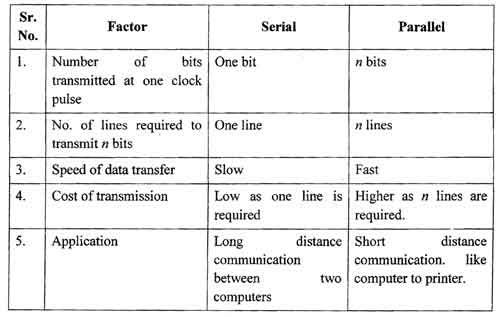Contents • • • • Parallel Data [ ] The parallel port on modern computer systems is an example of a parallel communications connection. The parallel port has 8 data wires, and a large series of ground wires and control wires. IDE hard-disk connectors and PCI expansion ports are another good example of parallel connections in a computer system. Serial Data [ ] The serial port on modern computers is a good example of serial communications. Serial ports have either a single data wire, or a single differential pair, and the remainder of the wires are either ground or control signals. USB, FireWire, SATA and PCI Express are good examples of other serial communications standards in modern computers.

Which is Better? [ ] It is a natural question to ask which one of the two transmission methods is better. At first glance, it would seem that parallel ports should be able to send data much faster than serial ports. Let's say we have a parallel connection with 8 data wires, and a serial connection with a single data wire. Simple arithmetic seems to show that the parallel system can transmit 8 times as fast as the serial system.
However, parallel ports suffer extremely from inter-symbol interference (ISI) and noise, and therefore the data can be corrupted over long distances. Also, because the wires in a parallel system have small amounts of capacitance and mutual inductance, the bandwidth of parallel wires is much lower than the bandwidth of serial wires.
We all know by now that an increased bandwidth leads to a better bit rate. We also know that less noise in the channel means we can successfully transmit data reliably with a lower Signal-to-Noise Ratio, SNR. If, however, we bump up the power in a serial connection by using a differential signal with 2 wires (one with a positive voltage, and one with a negative voltage), we can use the same amount of power, have twice the SNR, and reach an even higher bitrate without suffering the effects of noise. USB cables, for instance, use shielded, differential serial communications, and the USB 2.0 standard is capable of data transmission rates of 480Mbits/sec! In addition, because of the increased potential for noise and interference, parallel wires need to be far shorter than serial wires. Consider the standard parallel port wire to connect the PC to a printer: those wires are between 3 and 4 feet long, and the longest commercially available is typically 25 meter(75 feet). Now consider Ethernet wires (which are serial, and typically unshielded twisted pair): they can be bought in lengths of 100 meters (300 feet), and a 300 meters (900 feet) run is not uncommon!
There is nothing VPS Avenger can't do, it offers you tons of features and a gigantic growing library from some of the best sound designers on this planet. Analog chorus, Reverb, Phaser etc. Features: VST / PC & Intel Mac VST / AU & AAX - runs in all compatible hosts 64 Bit and VST3 standard (64Bit is required!) over 900 factory presets 620 multisamples 218 special samples (attacks, noises) 154 resampler waves 168 drumkits, 168 drumsequences 596 wavetables thousands of OSC shapes (waveforms) available 30 fx types (incl. Vengeance producer suite avenger mac torrent 1.
Data transmission refers to the movement of data in form of bits between two or more digital devices. Disadvantage of parallel transmission. So in order to change this parallel data into serial data, conversion devices are used. The advantage of this method is that it does not require any local storage at the terminal. The Difference Between Serial & Parallel Data Transfer by G.S. Jackson While the use of peripheral devices with Universal Serial Bus (USB) connections is ubiquitous at this point, there are still some devices, such as older printers, that use older connections such as parallel cables.
UART, USART [ ] A Universal Asynchronous Receiver/Transmitter (UART) peripheral is used in embedded systems to convert bytes of data to bit strings which may be transmitted asynchronously using a serial protocol like RS-232. A Universal Synchronous/Asynchronous Receiver/Transmitter (USART) peripheral is just like a UART peripheral, except there is also a provision for synchronous transmission by means of a clock signal which is generated by the transmitter.
Parallel versus serial communication. In and, serial communication is the process of sending one at a time, sequentially, over a. This is in contrast to, where several bits are sent as a whole, on a link with several parallel channels. Serial communication is used for all and most, where the cost of and difficulties make parallel communication impractical. Serial computer buses are becoming more common even at shorter distances, as improved and transmission speeds in newer serial technologies have begun to outweigh the parallel bus's advantage of simplicity (no need for serializer and deserializer, or ) and to outstrip its disadvantages (, interconnect density). The migration from to is an example.